Effect of Torrefaction on the Physiochemical Characteristics and Pyrolysis of the Corn Stalk
Abstract
:1. Introduction
2. Materials and Methods
2.1. Biomass Feedstock Preparation
2.2. Experimental Process
2.3. Analytical Procedures
3. Results and Discussion
3.1. Fuel Characteristics of Raw and Torrefied Corn Stalk
3.2. Fiber and XRD Analysis
3.3. FTIR Analysis
3.4. Morphological Characterization Analysis
3.5. Pyrolysis Product Distribution of Torrefied Corn Stalk
3.6. Pyrolysis Gas Products of Torrefied Corn Stalk
4. Conclusions
Author Contributions
Funding
Institutional Review Board Statement
Data Availability Statement
Acknowledgments
Conflicts of Interest
References
- Haykiri-Acma, H.; Yaman, S.; Kucukbayrak, S. Effects of torrefaction on lignin-rich biomass (hazelnut shell): Structural variations. J. Renew. Sustain. Energy 2017, 9, 6. [Google Scholar] [CrossRef]
- Iqbal, T.; Dong, C.Q.; Lu, Q.; Ali, Z.; Khan, I.; Hussain, Z.; Abbas, A. Sketching Pakistan’s energy dynamics: Prospects of biomass energy. J. Renew. Sustain. Energy 2018, 10, 2. [Google Scholar] [CrossRef]
- Chen, C.Y.; Chen, W.H. Co-torrefaction followed by co-combustion of intermediate waste epoxy resins and woody biomass in the form of mini-pellet. Int. J. Energy Res. 2020, 44, 9317–9332. [Google Scholar] [CrossRef]
- Cen, K.; Zhang, J.; Chen, D.; Chen, F.; Zhang, Y.; Ma, H. Comparative study of the fuel quality and torrefaction performance of biomass and its molded pellets: Effects of temperature and residence time. Energy Sources Part A 2020, 1–10. [Google Scholar] [CrossRef]
- Jalalabadi, T.; Drewery, M.; Tremain, P.; Wilkinson, J.; Moghtaderi, B.; Allen, J. The impact of carbonate salts on char formation and gas evolution during the slow pyrolysis of biomass, cellulose, and lignin. Sustain. Energy Fuels 2020, 4, 5987–6003. [Google Scholar] [CrossRef]
- Thanapal, S.S.; Annamalai, K.; Ansley, R.J.; Ranjan, D. Co-firing carbon dioxide-torrefied woody biomass with coal on emission characteristics. Biomass Convers. Biorefinery 2015, 6, 91–104. [Google Scholar] [CrossRef]
- Singh, R.K.; Sarkar, A.; Chakraborty, J.P. Effect of torrefaction on the physicochemical properties of pigeon pea stalk (Cajanus cajan) and estimation of kinetic parameters. Renew. Energy 2019, 138, 805–819. [Google Scholar] [CrossRef]
- Chen, W.H.; Liu, S.H.; Juang, T.T.; Tsai, C.M.; Zhuang, Y.Q. Characterization of solid and liquid products from bamboo torrefaction. Appl. Energy 2015, 160, 829–835. [Google Scholar] [CrossRef]
- Fan, Y.; Li, L.; Tippayawong, N.; Xia, S.; Cao, F.; Yang, X.; Zheng, A.; Zhao, Z.; Li, H. Quantitative structure-reactivity relationships for pyrolysis and gasification of torrefied xylan. Energy 2019, 188, 116119. [Google Scholar] [CrossRef]
- Korshunov, A.; Kichatov, B.; Melnikova, K.; Gubernov, V.; Yakovenko, I.; Kiverin, A.; Golubkov, A. Pyrolysis characteristics of biomass torrefied in a quiescent mineral layer. Energy 2019, 187, 116015. [Google Scholar] [CrossRef]
- Zhang, C.; Ho, S.H.; Chen, W.H.; Xie, Y.; Liu, Z.; Chang, J.S. Torrefaction performance and energy usage of biomass wastes and their correlations with torrefaction severity index. Appl. Energy 2018, 220, 598–604. [Google Scholar] [CrossRef]
- Likun, P.K.W.; Zhang, H. Insights into pyrolysis of torrefied-biomass, plastics/tire and blends: Thermochemical behaviors, kinetics and evolved gas analyses. Biomass Bioenergy 2020, 143, 105852. [Google Scholar]
- Zheng, A.; Zhao, Z.; Huang, Z.; Zhao, K.; Wei, G.; Wang, X.; He, F.; Li, H. Catalytic Fast Pyrolysis of Biomass Pretreated by Torrefaction with Varying Severity. Energy Fuel 2014, 28, 5804–5811. [Google Scholar] [CrossRef]
- Wang, S.; Dai, G.; Yang, H.; Luo, Z. Lignocellulosic biomass pyrolysis mechanism: A state-of-the-art review. Prog. Energy Combust. 2017, 62, 33–86. [Google Scholar] [CrossRef]
- Singh, S.; Chakraborty, J.P.; Mondal, M.K. Pyrolysis of torrefied biomass: Optimization of process parameters using response surface methodology, characterization, and comparison of properties of pyrolysis oil from raw biomass. J. Clean. Prod. 2020, 272, 122517. [Google Scholar] [CrossRef]
- Kumar, G.; Shobana, S.; Chen, W.H.; Bach, Q.V.; Kim, S.H.; Atabani, A.E.; Chang, J.S. A review of thermochemical conversion of microalgal biomass for biofuels: Chemistry and processes. Green Chem. 2017, 19, 44–67. [Google Scholar] [CrossRef]
- Xin, S.; Huang, F.; Liu, X.; Mi, T.; Xu, Q. Torrefaction of herbal medicine wastes: Characterization of the physicochemical properties and combustion behaviors. Bioresour. Technol. 2019, 287, 121408. [Google Scholar] [CrossRef]
- Cahyanti, M.N.; Doddapaneni, T.R.K.C.; Kikas, T. Biomass torrefaction: An overview on process parameters, economic and environmental aspects and recent advancements. Bioresour. Technol. 2020, 301, 122737. [Google Scholar] [CrossRef]
- Chen, D.; Li, Y.; Cen, K.; Luo, M.; Li, H.; Lu, B. Pyrolysis polygeneration of poplar wood: Effect of heating rate and pyrolysis temperature. Bioresour. Technol. 2016, 218, 780–788. [Google Scholar] [CrossRef]
- Chen, W.H.; Peng, J.; Bi, X.T. A state-of-the-art review of biomass torrefaction, densification and applications. Renew. Sustain. Energy Rev. 2015, 44, 847–866. [Google Scholar] [CrossRef]
- Szwaja, S.; Magdziarz, A.; Zajemska, M.; Poskart, A. A torrefaction of Sida hermaphrodita to improve fuel properties. Advanced analysis of torrefied products. Renew. Energy 2019, 141, 894–902. [Google Scholar] [CrossRef]
- Keivani, B.; Gultekin, S.; Olgun, H.; Atimtay, A.T. Torrefaction of pine wood in a continuous system and optimization of torrefaction conditions. Int. J. Energy Res. 2018, 42, 4597–4609. [Google Scholar] [CrossRef]
- Bach, Q.V.; Skreiberg, Ø. Upgrading biomass fuels via wet torrefaction: A review and comparison with dry torrefaction. Renew. Sustain. Energy Rev. 2016, 54, 665–677. [Google Scholar] [CrossRef]
- Niu, Y.; Lv, Y.; Lei, Y.; Liu, S.; Liang, Y.; Wang, D.; Hui, S.E. Biomass torrefaction: Properties, applications, challenges, and economy. Renew. Sustain. Energy Rev. 2019, 115, 109395. [Google Scholar] [CrossRef]
- Bach, Q.V.; Chen, W.H.; Chu, Y.S.; Skreiberg, Ø. Predictions of biochar yield and elemental composition during torrefaction of forest residues. Bioresour. Technol. 2016, 215, 239–246. [Google Scholar] [CrossRef] [PubMed]
- Chen, W.H.; Lu, K.M.; Lee, W.J.; Liu, S.H.; Lin, T.C. Non-oxidative and oxidative torrefaction characterization and SEM observations of fibrous and ligneous biomass. Appl. Energy 2014, 114, 104–113. [Google Scholar] [CrossRef]
- Sukiran, M.A.; Abnisa, F.; Daud, W.M.A.W.; Bakar, N.A.; Loh, S.K. A review of torrefaction of oil palm solid wastes for biofuel production. Energy Convers. Manag. 2017, 149, 101–120. [Google Scholar] [CrossRef]
- Kanwal, S.; Chaudhry, N.; Munir, S.; Sana, H. Effect of torrefaction conditions on the physicochemical characterization of agricultural waste (sugarcane bagasse). Waste Manag. 2019, 88, 280–290. [Google Scholar] [CrossRef]
- Li, M.F.; Chen, C.Z.; Li, X.; Shen, Y.; Bian, J.; Sun, R.C. Torrefaction of bamboo under nitrogen atmosphere: Influence of temperature and time on the structure and properties of the solid product. Fuel 2015, 161, 193–196. [Google Scholar] [CrossRef]
- Cardona, S.; Gallego, L.J.; Valencia, V.; Martínez, E.; Rios, L.A. Torrefaction of eucalyptus-tree residues: A new method for energy and mass balances of the process with the best torrefaction conditions. Sustain. Energy Technol. 2019, 31, 17–24. [Google Scholar] [CrossRef]
- Colin, B.; Dirion, J.L.; Arlabosse, P.; Salvador, S. Quantification of the torrefaction effects on the grindability and the hygroscopicity of wood chips. Fuel 2017, 197, 232–239. [Google Scholar] [CrossRef]
- Mei, Y.; Yang, Q.; Yang, H.; Lin, G.; Li, J.; Chen, Y.; Zhang, S.; Chen, H. Low temperature deoxidization of biomass and its release characteristics of gas products. Ind. Crop. Prod. 2018, 123, 142–153. [Google Scholar] [CrossRef]
- Hu, Q.; Yang, H.; Xu, H.; Wu, Z.; Lim, C.J.; Bi, X.T.; Chen, H. Thermal behavior and reaction kinetics analysis of pyrolysis and subsequent in-situ gasification of torrefied biomass pellets. Energy Convers. Manag. 2018, 161, 205–214. [Google Scholar] [CrossRef]
- Boateng, A.A.; Mullen, C.A. Fast pyrolysis of biomass thermally pretreated by torrefaction. J. Anal. Appl. Pyrolysis 2013, 100, 95–102. [Google Scholar] [CrossRef]
- Xin, S.; Huang, F.; Qi, W.; Mi, T. Pyrolysis of torrefied herbal medicine wastes: Characterization of pyrolytic products. Energy 2020, 210, 118455. [Google Scholar] [CrossRef]
- Chen, D.; Cen, K.; Cao, X.; Li, Y.; Zhang, Y.; Ma, H. Restudy on torrefaction of corn stalk from the point of view of deoxygenation and decarbonization. J. Anal. Appl. Pyrolysis 2018, 135, 85–93. [Google Scholar] [CrossRef]
- Gupta, G.K.; Mondal, M.K. Bio-energy generation from sagwan sawdust via pyrolysis: Product distributions, characterizations and optimization using response surface methodology. Energy 2019, 170, 423–437. [Google Scholar] [CrossRef]
- Ma, Z.; Zhang, Y.; Shen, Y.; Wang, J.; Yang, Y.; Zhang, W.; Wang, S. Oxygen migration characteristics during bamboo torrefaction process based on the properties of torrefied solid, gaseous, and liquid products. Biomass Bioenergy 2019, 128, 105300. [Google Scholar] [CrossRef]
- Ma, Z.; Chen, D.; Gu, J.; Bao, B.; Zhang, Q. Determination of pyrolysis characteristics and kinetics of palm kernel shell using TGA–FTIR and model-free integral methods. Energy Convers. Manag. 2015, 89, 251–259. [Google Scholar] [CrossRef]
- Li, M.F.; Li, X.; Bian, J.; Chen, C.Z.; Yu, Y.T.; Sun, R.C. Effect of temperature and holding time on bamboo torrefaction. Biomass Bioenergy 2015, 83, 366–372. [Google Scholar] [CrossRef]
- Wang, L.; Barta-Rajnai, E.; Skreiberg, Ø.; Khalil, R.; Czégény, Z.; Jakab, E.; Barta, Z.; Grønli, M. Effect of torrefaction on physiochemical characteristics and grindability of stem wood. stump and bark. Appl. Energy 2018, 227, 137–148. [Google Scholar] [CrossRef]
- He, Y.; Zhang, S.; Liu, D.; Xie, X.; Li, B. Effect of Biomass Particle Size on the Torrefaction Characteristics in a Fixed-Bed Reactor. Energies 2023, 16, 1104. [Google Scholar] [CrossRef]
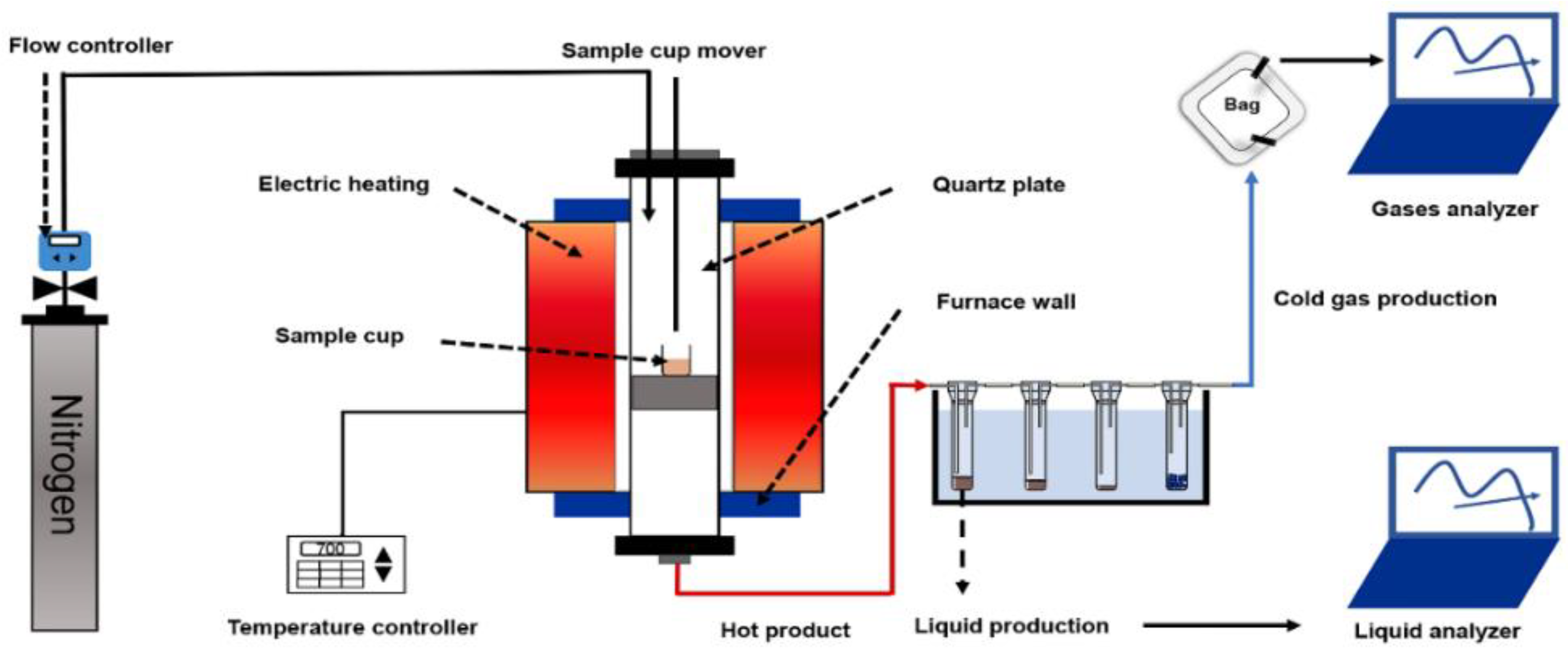
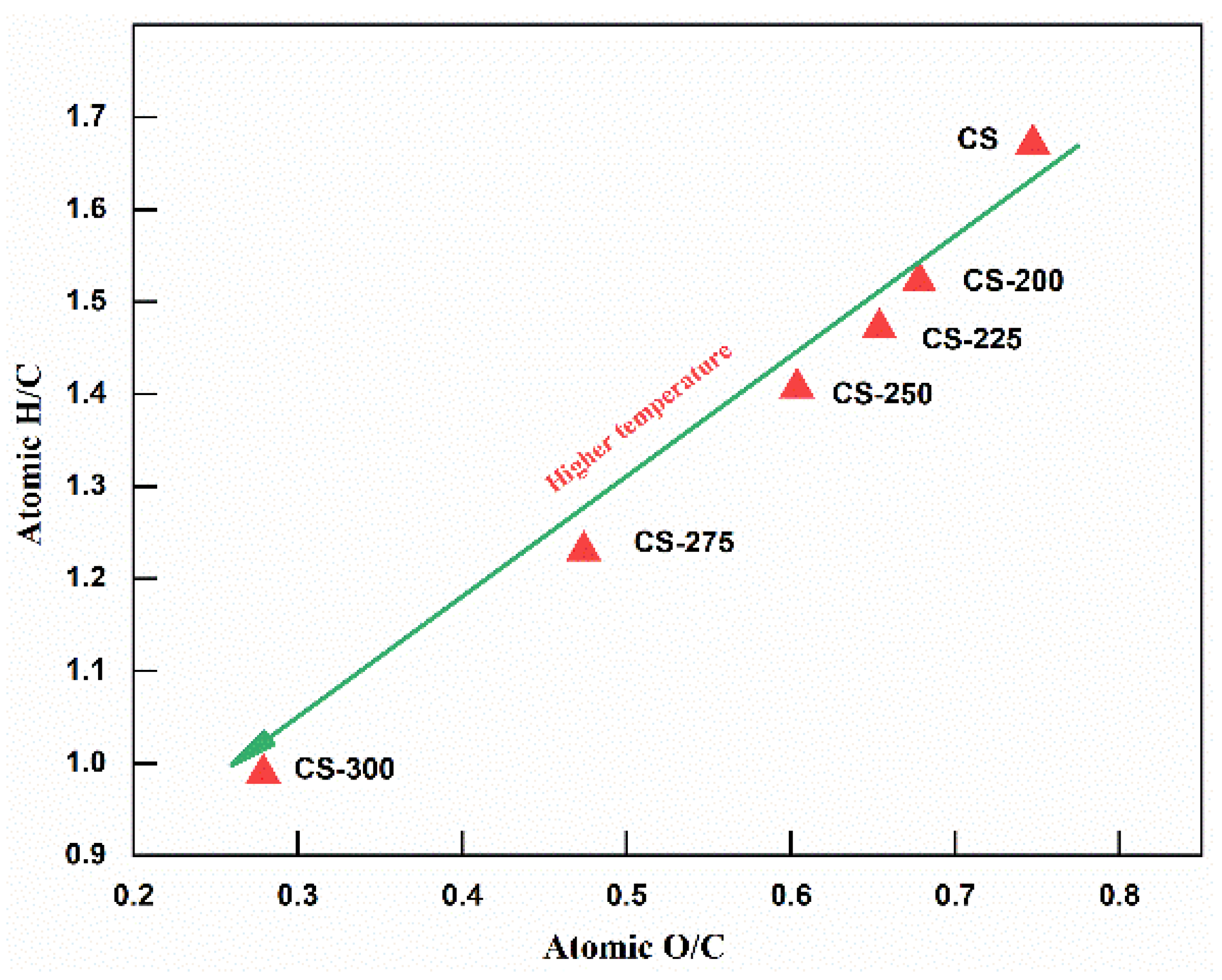



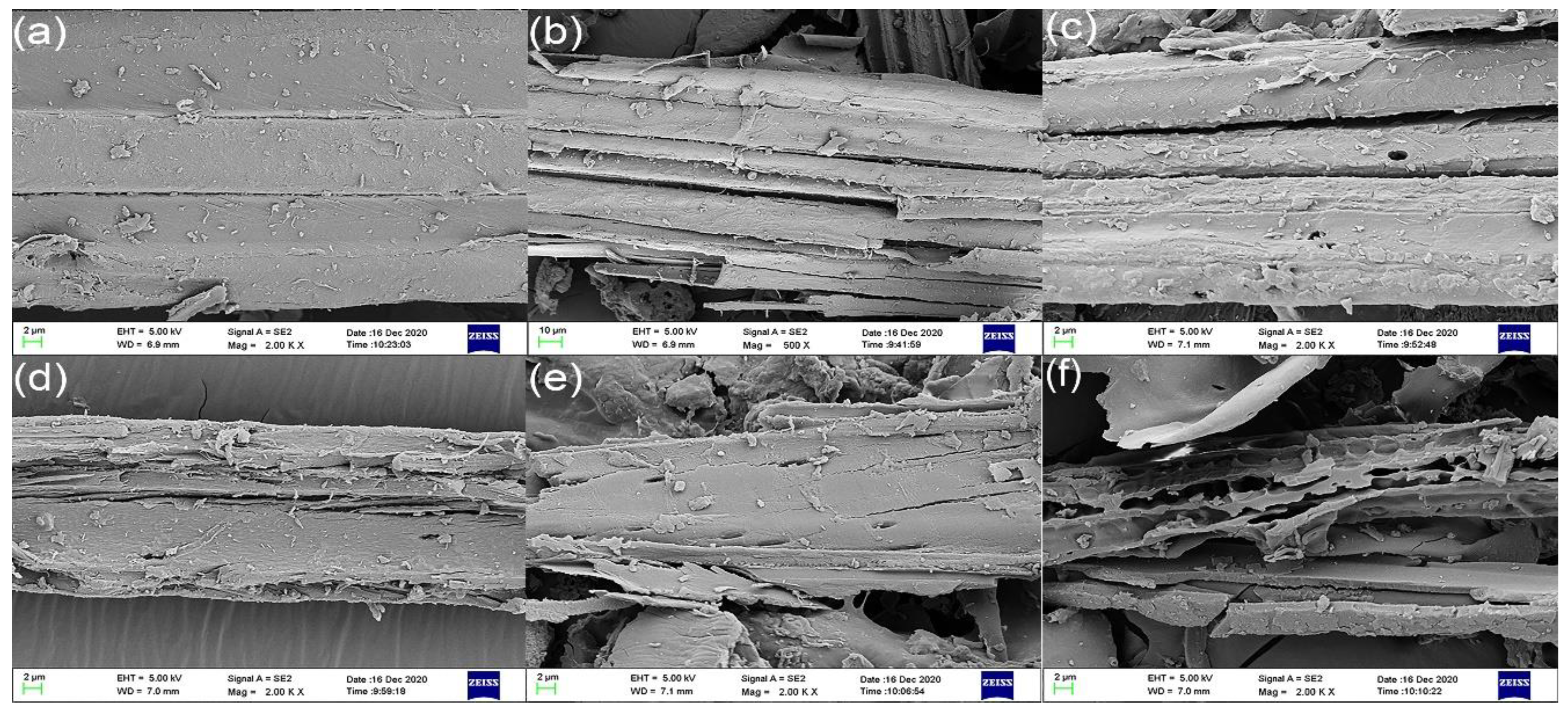

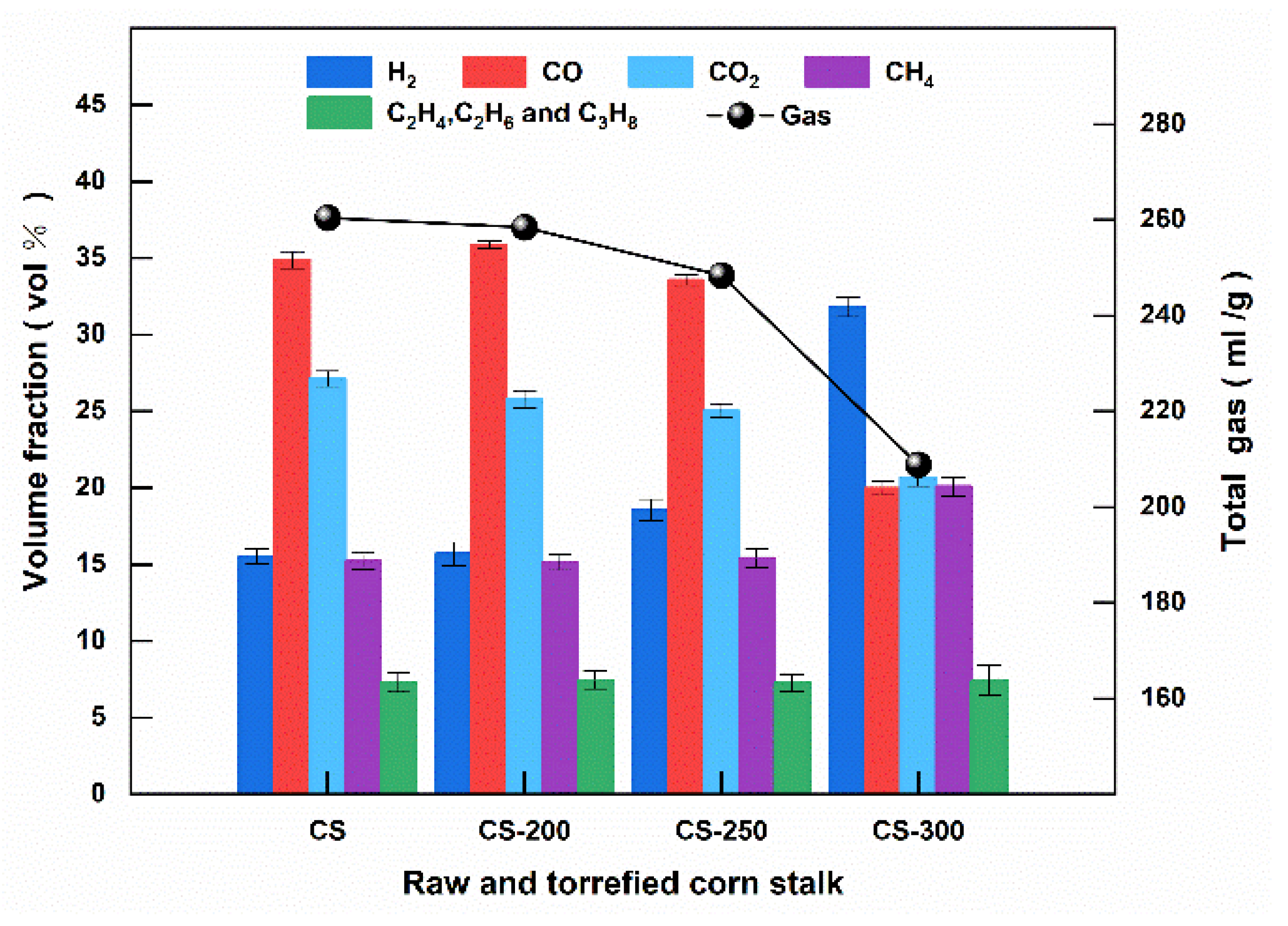
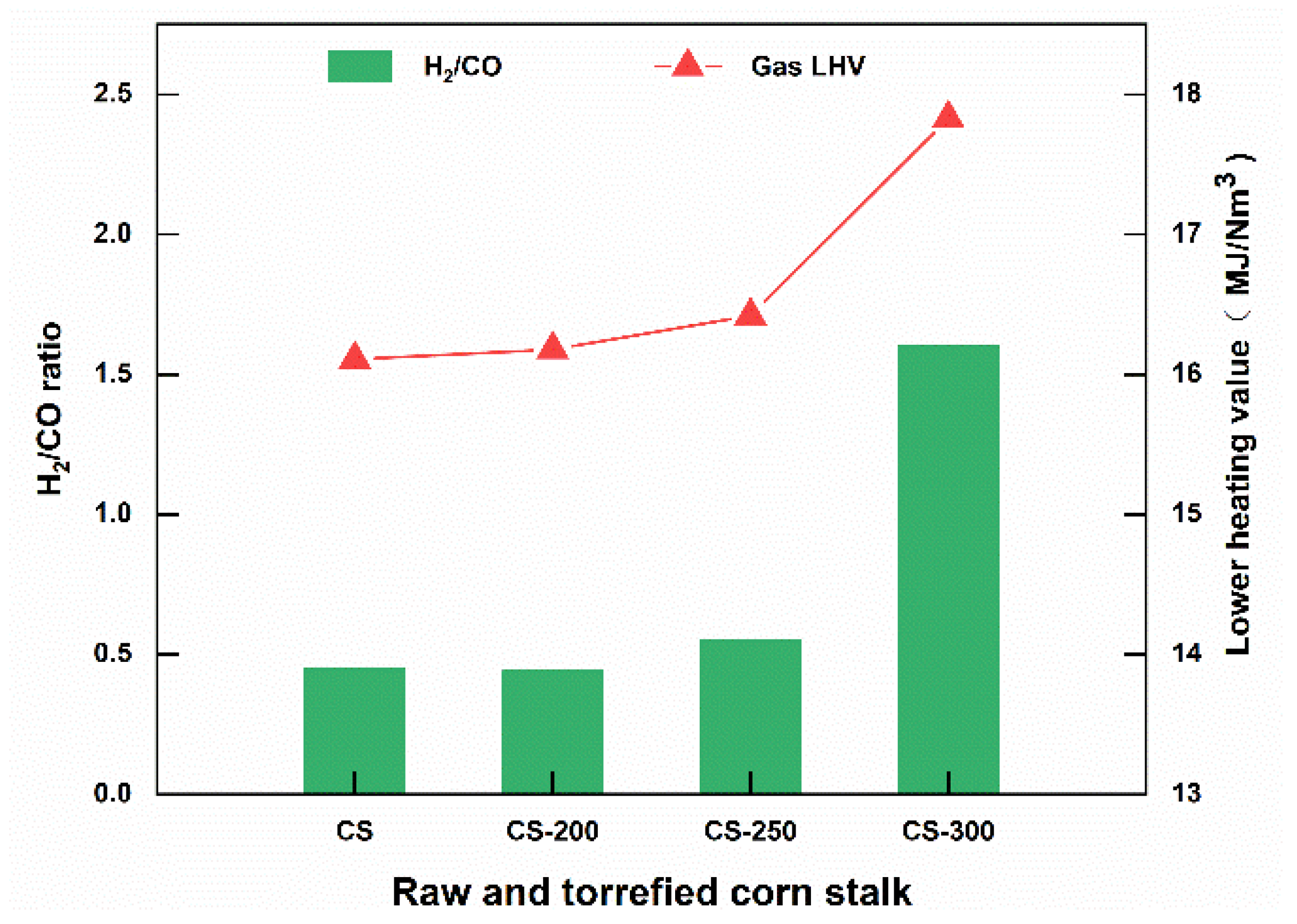
| Sample | VM | FC | Ash | C | H | O | N | S | HHV |
|---|---|---|---|---|---|---|---|---|---|
| CS | 71.44 | 19.87 | 8.69 | 41.96 | 5.84 | 41.81 | 1.09 | 0.60 | 15.48 |
| CS-200 | 70.23 | 20.64 | 9.13 | 44.03 | 5.59 | 39.81 | 1.19 | 0.25 | 15.58 |
| CS-225 | 69.11 | 21.52 | 9.37 | 44.77 | 5.49 | 39.03 | 1.10 | 0.24 | 15.96 |
| CS-250 | 65.76 | 24.09 | 10.15 | 45.84 | 5.37 | 36.90 | 1.51 | 0.23 | 16.18 |
| CS-275 | 57.38 | 30.50 | 12.12 | 49.78 | 5.10 | 31.45 | 1.39 | 0.15 | 18.31 |
| CS-300 | 41.79 | 42.22 | 15.99 | 56.16 | 4.63 | 20.89 | 2.09 | 0.24 | 21.31 |
Disclaimer/Publisher’s Note: The statements, opinions and data contained in all publications are solely those of the individual author(s) and contributor(s) and not of MDPI and/or the editor(s). MDPI and/or the editor(s) disclaim responsibility for any injury to people or property resulting from any ideas, methods, instructions or products referred to in the content. |
© 2023 by the authors. Licensee MDPI, Basel, Switzerland. This article is an open access article distributed under the terms and conditions of the Creative Commons Attribution (CC BY) license (https://creativecommons.org/licenses/by/4.0/).
Share and Cite
Chen, L.; Chen, X.; Zhao, Y.; Xie, X.; Yang, S.; Hua, D.; Wang, C.; Li, T. Effect of Torrefaction on the Physiochemical Characteristics and Pyrolysis of the Corn Stalk. Polymers 2023, 15, 4069. https://doi.org/10.3390/polym15204069
Chen L, Chen X, Zhao Y, Xie X, Yang S, Hua D, Wang C, Li T. Effect of Torrefaction on the Physiochemical Characteristics and Pyrolysis of the Corn Stalk. Polymers. 2023; 15(20):4069. https://doi.org/10.3390/polym15204069
Chicago/Turabian StyleChen, Lei, Xiangqian Chen, Yuxiao Zhao, Xinping Xie, Shuangxia Yang, Dongliang Hua, Chuanlei Wang, and Tianjin Li. 2023. "Effect of Torrefaction on the Physiochemical Characteristics and Pyrolysis of the Corn Stalk" Polymers 15, no. 20: 4069. https://doi.org/10.3390/polym15204069
APA StyleChen, L., Chen, X., Zhao, Y., Xie, X., Yang, S., Hua, D., Wang, C., & Li, T. (2023). Effect of Torrefaction on the Physiochemical Characteristics and Pyrolysis of the Corn Stalk. Polymers, 15(20), 4069. https://doi.org/10.3390/polym15204069







